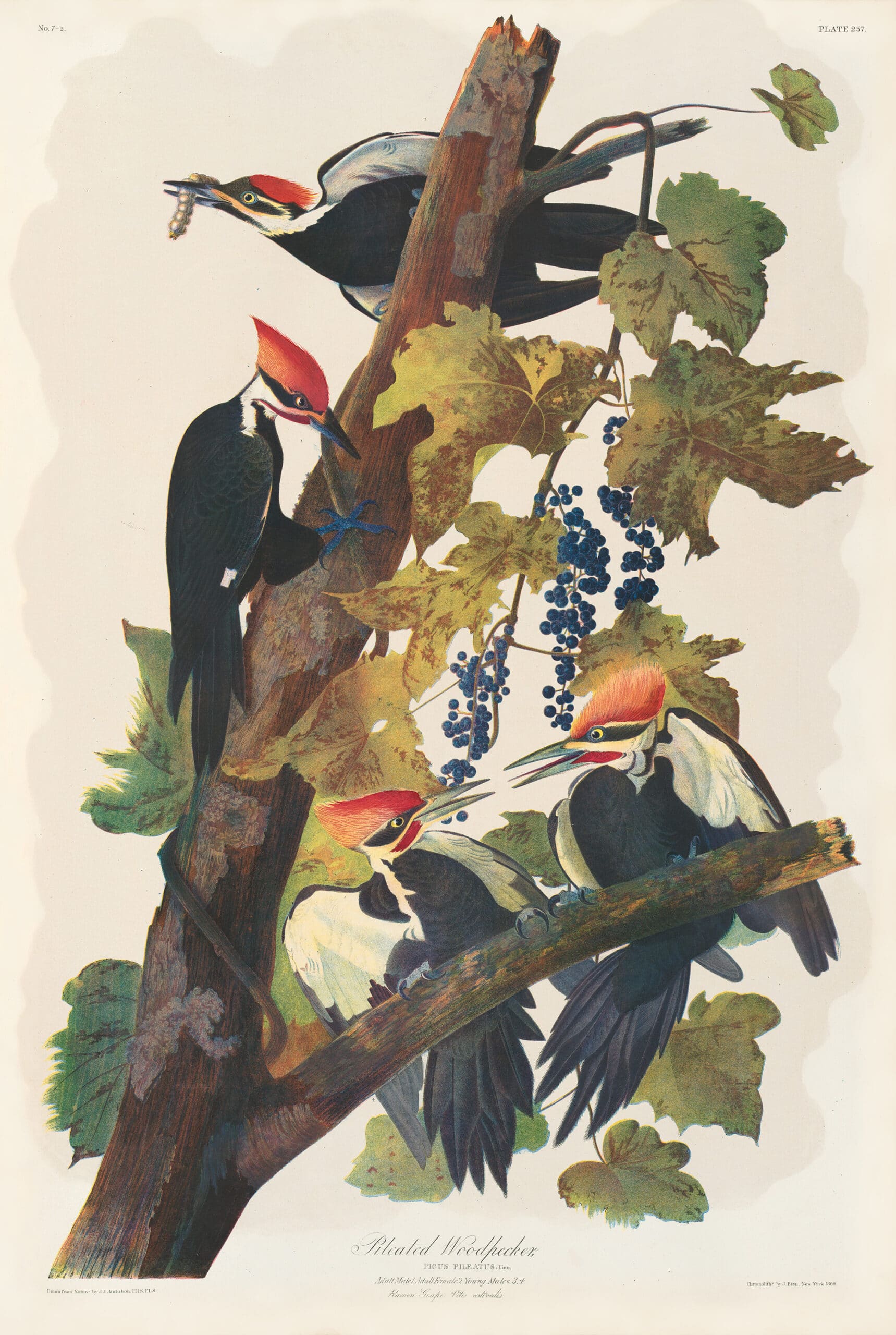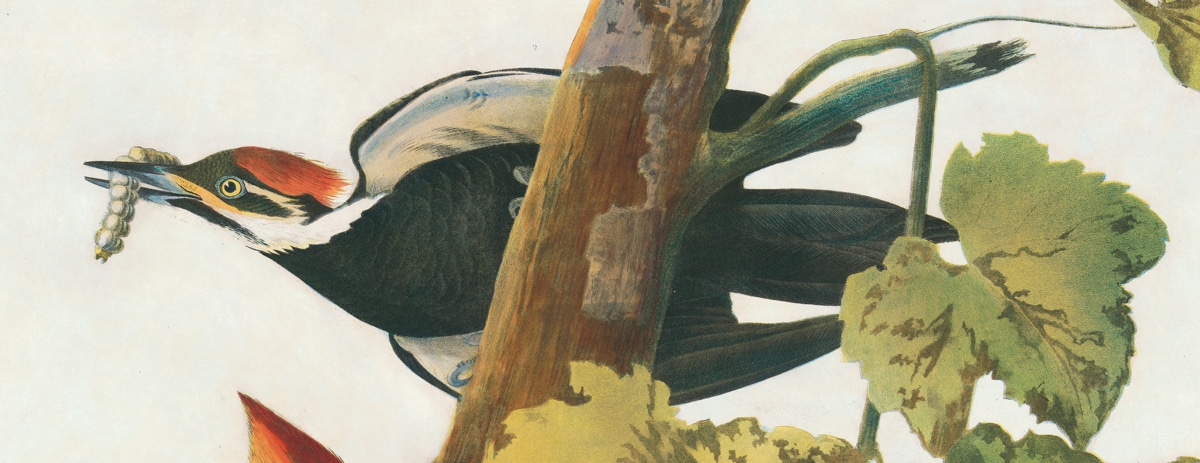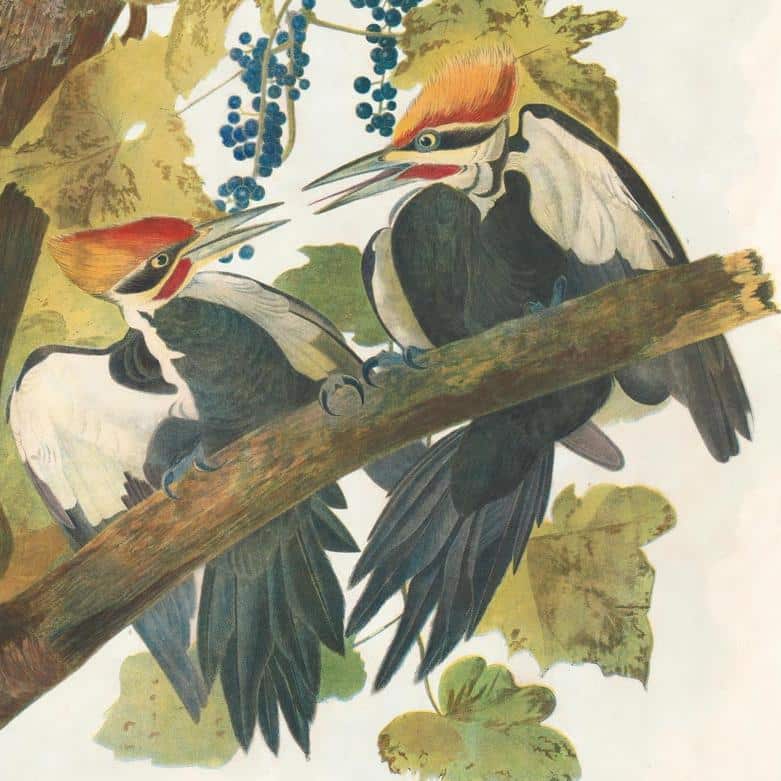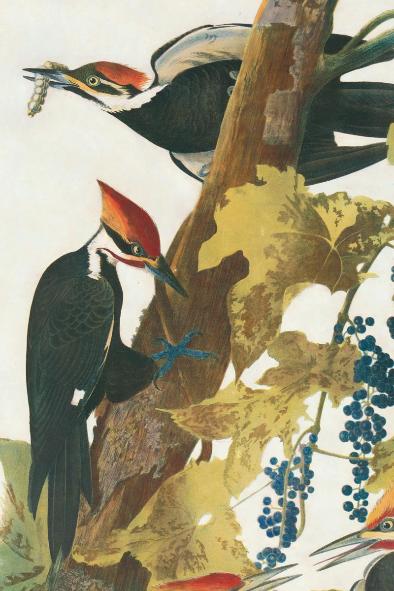Audubon Prints, Birds and Animal Art
Symbiosis of Art and Science in Audubon’s Pileated Woodpecker
The twofold nature of Audubon’s prints as both artistic and scientific is exemplified in his Bien edition lithograph the Pileated Woodpecker through its synthesis of aesthetic and didactic elements.
Table of Contents
- Compositional Rhythm in the Artwork
- Maturation of the Species
- Environmental Context
- Chromolithography
- The Bien Edition
On the one hand, the print serves as an instructive template elucidating the habits, diet, and maturation pattern of the depicted species, therefore catering to the tradition of scientific taxonomy. On the other hand, the lithograph employs an artistic vocabulary through its shape, linework, and composition which treats us to a visual melody of decisive angularity coupled with sinuous curving contours to create an aesthetically pleasing, harmonious work of art. Moreover, it is through the implementation of chromolithography that the Pileated Woodpecker is placed at the nexus of art and science during the mid-nineteenth century.

Audubon Bien Ed. Pl. 257 Pileated Woodpecker
Original Chromolithograph; circa 1858-1860
view productCompositional Rhythm in the Artwork
In the Pileated Woodpecker, the birds and the environment work in harmony to direct our eyes throughout the lithograph. The carmine-peaked heads of the birds capture our attention and map out a visual pathway for us. First, we are drawn to the topmost bird, for she sits above the chaos and squabbles present below her perch. Her sleek head and sharp, skillful beak are pointed outward towards the emptiness of the left upper quadrant of the print. The female bird’s elevated head makes us aware of the environment beyond the print that we cannot see, but that is known to and present for her. A grub, secured within her relentless grasp, appears to have already accepted its inevitable fate as it wriggles its final wriggle.

Next, our eye is invited to wander down the lichen-covered tree trunk to where the male woodpecker adjusts himself to cast a stern glance at the squabbling youngsters below. There is a sharpness and angularity to the birds, emphasizing their aerodynamic quality and temperamental disposition, which Audubon records in his Ornithological Biography. He observes that “Their natural wildness never leaves them, even although they may have been reared from the nest” (Audubon 1831, 227).
In both his writing and his print Audubon endows them with an independent spirit and characterizes them as energetic, stubborn, and loyal. He explains how when attempting to catch the woodpecker, “It is then very difficult to kill it, and sometimes, when shot dead, it clings so firmly to the bark that it may remain hanging for hours” (Audubon 1831, 229). Likewise, the disagreeable bird is also objectionable to the cultivated human palate. Audubon explains, “Its flesh is tough, of a bluish tint, and smells so strongly of the worms and insects on which it generally feeds, as to be extremely unpalatable” (Audubon 1831, 230). We grasp the stubborn and cantankerous proclivity of the birds as well as their redeeming loyalty in Audubon’s illustration of the woodpecker’s wild, roving eyes, the energetic ruckus of the youngsters, and the apparent closeness of the tetrad.
Lastly, the adolescent birds, located to the lower right quadrant of the print, mirror one another as they squabble over concerns known only to juvenile woodpeckers. The positioning of the two young birds creates a diagonal arc across the page that is echoed by the curvature of the tree branch. Audubon very consciously intertwined the species he depicted with their environment in order to elucidate the symbiotic relationship of nature and its inhabitants. Moreover, the harmony of the birds in their habitat is echoed by the visual harmony of the artwork itself.
Maturation of the Species
In this lithograph, Audubon has included both the adolescent and mature birds specifically to demonstrate the distinction between a young and seasoned pileated woodpeckers bill. He explains, “The observation of many years has convinced me, that Woodpeckers of all sorts have the bill longer when just fledged than at any future period of their life, and that through use it becomes not only shorter, but also much harder, stronger, and sharper” (Audubon 1831, 230). The younger woodpeckers possess longer, softer, lighter bills that have yet to see the toughening and truncating effects of the woodpecker’s hammering enterprise. In contrast, the life of the fully-fledged woodpecker shortens, hardens, and darkens its bill. To reiterate this point, Audubon shows the young bills idly squabbling while the mature bills occupy themselves with scavenging.


Environmental Context
The bird’s perch, a lichen-covered rotting tree entangled with Racoon grapevines, bears the effects of a woodpecker’s visit and has been shorn of its protective bark. The wafer-like leaves drooping off the grape tendrils cascade down the composition in a whimsical manner that contrasts with the angularity, and defiant temperament of the birds. The aggressive vine, which satiates the appetite of the young birds who have yet to refine the talent of extracting worms from rotting wood, is known to smother neighboring trees and spread relentlessly throughout the surrounding forest. The fruit, deemed inedible for human consumption, is acrid and hard. The territorial, ornery, and defiant spirit of the birds and racoon grapevines alike are juxtaposed in this print to exacerbate the like-tendencies of the other.
Chromolithography
Unlike Audubon’s engraved edition of Birds of America, crafted by Havell between 1827 and 1838, the Bien edition of Birds is rendered through the newly evolved printing technology of chromolithography. Developed and refined in the mid to late 19th century, chromolithography allowed artists and publishers to print in color instead of hand-applying it after the fact as was done in the Havell edition. Likewise, chromolithography is a planographic process, which renders no embossment because the paper and the lithographic stone exist on the same plane. Furthermore, unlike engraving, which is predominantly a mechanical process by which lines are etched into a matrix, lithography is heavily reliant on chemical reactions.
Through the hydrophobic nature of oil, an image is drawn with a waxy crayon or substance onto a stone, which is then treated with gum arabic and acid to etch the grease-based image onto the stone’s surface. Then, when the stone is inked by the printmaker, the ink will only adhere to the areas that have been touched by the waxy crayon. Finally, the prepared stone is run through the press and the image is realized on paper. This process is repeated as many times as there are colors in a print, for each color requires a separate stone bearing the lines and silhouettes of that color exclusively.

Julius Bien painted by George Da Maduro Peixotto, 1886.
Oil on canvas from the National Portrait Gallery, Smithsonian Institution
The Bien Edition
The Bien edition, posthumously produced by Audubon’s family in collaboration with Julius Bien, a renowned printmaker in New York, was modeled after the Havell edition of Birds of America produced in London several decades prior. Audubon’s sons, John Woodhouse and Victor Gifford, spearheaded the Bien project in 1858 but were forced to curtail the endeavor by 1860 because of the onset of the American Civil War. As a result, only 105 of the original 435 prints were republished as chromolithographs in the Bien edition. For this reason, Bien edition prints of Audubon’s Birds are rarer than the Havell edition, but both provide unique insights into the development of printmaking during the 19th century. Moreover, the mechanical and chemical aspects of the print medium further bind together the disciplines of art and science in Audubon’s Pileated Woodpecker.



